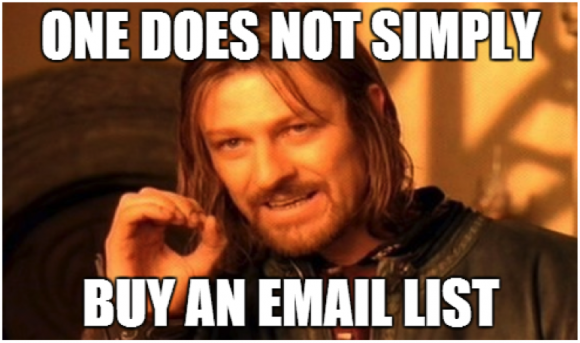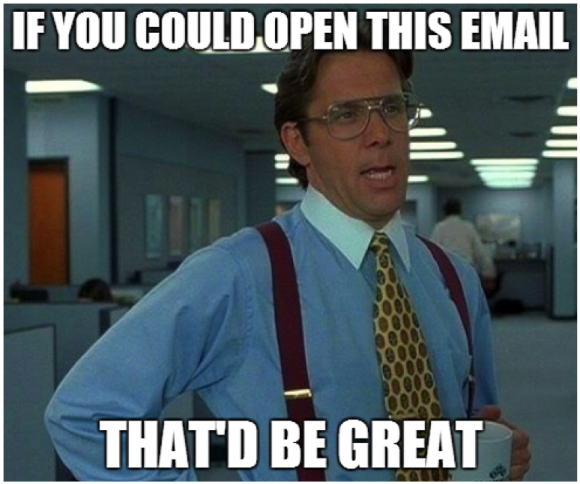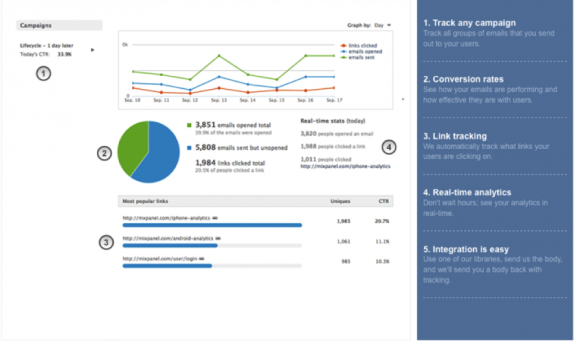15 of the Silliest Mistakes Email Marketers Make

Editor’s note: This post was written by Rohan, who creates digital master plans at E2M Solutions for companies seeking advanced search marketing services. He also works on mobile UX improvement for startups and sui generis brands at OnlyDesign.org. Hit him up on Google+ for a chat on any of these areas.
Email marketing is probably the most ubiquitous form of marketing there is today. With ExactTarget’s Channel Preference Survey of 2012 showing that 91% of internet users check their emails every single day, this statement is proven in real numbers. After all, checking our emails as soon as we wake up – often even before we’re out of bed – is an act that most of us are guilty of.
The same survey showed that 66% of consumers have made a purchase as a result of an email campaign that they’ve received. Other studies show that 74% of all users prefer to receive communications from brands via email over any other form of communication.
So if email is widely used and if customers look forward to brand communication via email, have all brands mastered the art of email marketing? Not really.
There are some very elementary mistakes that most brands make, thus messing up a perfectly good marketing opportunity. Let’s take a look.
1. Buying Email Lists
Something that was looked down upon even in the early years of email marketing, a bought out email list is a true death wish in today’s day and age.
Not only are bought out lists overused, unresponsive and often totally unrepresentative of a brand’s real users, sending out email campaigns to such databases can very quickly land you in the scanner of the CAN-SPAM Act of 2003 and penalize your brand and its marketing forever.
How to Use the Art of Email Marketing to Launch Your Blog & Start Converting
2. Not Asking for Permission
Taking the thought of purchased lists one step further, sending email campaigns to users who have not explicitly signed up to receive communication from your brand is risking your brand’s online reputation and lowering its equity among customers who value their privacy and right to choose. Unfortunately many brands, especially in the e-commerce domain, consider the act of purchase made by the customer from their site as an implicit agreement on their part to receive marketing communication via email. Nothing could be further from the truth.
A big plus for opted-in email databases is that their deliverability rates are close to 100%. Not just spot-on deliverability, opted in databases also show much higher open rates, CTRs and conversions compared to non-permission based email marketing.
3. Not Building Domain Authority
This relates typically to new brands or to established brands that are sending out emails from a new domain name. It takes a while for email service providers to recognize and rate positively new email domains that reach out to thousands of users. Authority takes time and repeated send outs to be steadily built up over time.
It is worth taking things slow in the beginning and splitting one’s database to reach out to smaller sets of customers at a time to gradually build up ones domain authority and improve deliverability and open rates.
4. Focusing on Selling instead of Relationship Building
Email marketing is a means to forge a long term relationship with your customer. Brands that take a short term view of things by using email to just sell, sell, sell are simply wasting a golden opportunity at gaining a customer for life.
Provide content via your emails that your customer will appreciate. If you are a fashion retailer, maybe you could offer fashion tips and tricks in your email campaigns besides showcasing your products. Use email to wish customers on their birthdays, anniversaries, important milestones in their interaction with your brand – basically things that make them realize that you see them as more than just a statistic.
5. Not Testing Emails before Sending Them Out
Emails have so many variables that affect them that every single send out is unique in itself. Never, ever, send out an email without testing out various subject lines, design options, and other elements. Do try playing around with the content of the email to see what works best.
Most email marketing software have testing tools built right in. Use them to avoid cutting a sorry figure later, with an email that does not open at all or one that breaks up on opening.
6. Spamming Users
While out of sight definitely means out of mind in the marketing world, distance does make the heart grow fonder. Your job as an email marketer is to arrive at a happy medium between too few emails vs. too many.
There is no magic number or frequency, as it depends heavily on the type of users you have, the industry in which you operate, and type of content that you send out. Use email A/B tests using tools like GetResponse to figure out which frequency works best for your customers and stick to it. Do not succumb to the temptation of spamming your users.
7. One Size Fits All Content
Just as every customer is distinctive in her tastes, the communication to every customer too ought to be tailored to their needs, likes, profile information and past purchase history.
Mass mailing the same content to the entire database means there will be tons of customers for whom the content was totally irrelevant. These are the guys who’ll not bother opening future emails from you.
Segment your list based on customer data and send out customized campaigns to each segment for maximizing your conversions.
8. Repetitive Content
While on the subject of content, make sure every campaign of yours has fresh, unique content that a user would look forward to reading. Sending them the same stuff over and over again is a surefire way of boring them to death and chasing them away permanently.
Create distinct categories of content that will resonate with your audience, occasions that they will appreciate hearing from you or even the various types of triggered emails that work best with different customer segments. Use a project collaboration tool like WorkZone to draw up and schedule your content calendar and manage your writers, researchers, graphic designers and other creative who will coordinate on your content creation and marketing process.
9. Boring Subject Lines
So you’ve managed to create some brilliant content that your users will be dying for. However, if your subject lines are boring as yesterday evening’s news; all your effort in creating great content goes straight down the drain.
Your subject line is the hook that tempts a user to peek inside an email. Pick an interesting subject that is directly related to your content and which catches the eye easily. Make sure your subject lines do not exceed 65 characters in length to allow them to be read easily even when a user checks the email on mobile.
10. Invisible Calls to Action
An email communication, like all other pieces of marketing communication, is expected to perform some very clear actions. Either it is making the customer buy something from your site, sign up for a subscription, or even just make the customer feel good by offering them a free goodie.
When you have so many objectives from an email being sent out, isn’t it obvious that you should tell your customer the exact action that is expected out of them? Make sure you have one single, call to action that is loud, clear and unmissable by any customer.
11. Ignoring Email Analytics
Just as website analytics is not just about traffic and page views, email analytics is a lot more than open rates and CTRs (click-through rates). Email analytics gives you in-depth information about how each and every customer interacted with your email.
Most analytics packages allow you to retrace each customer action back to unique email IDs, thus painting a complete picture of a customer, her likes, dislikes and levels of interest in your email content. Use this data to see how well each piece of content in your email performs and tweak your email strategies based on insights drawn from analytics on a real-time basis.
12. Not Optimizing for Mobile
More than 50% of all emails are now accessed first through mobile devices. To be more precise, 38% of all emails are opened on iOS devices, 12% on Android devices and 1% on Windows, Bada and other platforms.
An email that is not mobile optimized runs the risk of not displaying correctly on different screen sizes, images not loading correctly, and getting overall a much lower click rate as compared to mobile optimized emails.
13. Not Optimizing for Email Clients or Browsers
Emails sent out to large audiences need to render as well on older machines with outdated software as on the latest ones. Different email clients have different peculiarities. For example, until recently Gmail automatically blocked all images in promotional emails. If your email is basically one large image file, guess what – your Gmail users will see nothing from your message. A good mix of images and text is key to handle such scenarios. Another important step is to add Alt tags to all images in an email. This way, even if the image is blocked the user will know what it was supposed to be.
14. Not Updating Your Database
Research data from Marketing Sherpas has shown that a database decays by 22.5% every year. This means at least 25% of email IDs in a given database would have either stopped responding to or unsubscribed from your emails. There could be some email IDs that are no longer active and which give you bounce backs each time you send them communication. A high bounce rate and unsubscribe rate lowers your domain authority and lowers the deliverability of your email campaigns.
Clean out these email IDs from your database and replenish the lost IDs by constantly capturing new IDs from your website, blog, social media, even at cash registers in your traditional retail stores.
15. Content Not Shareable
Long before social media was even conceived, people shared interesting information, jokes, anecdotes or helpful hints by forwarding emails to a large set of people.
If you have interesting content in your emails, people will want to share it with their friends and family. Allow them to do this with ease by prominently placing social sharing buttons on your emails. You can even place a ‘Forward to friends and family’ button that is built into the email itself.
Over to You
So that was my roundup of the top 15 email marketing boo-boos many brands do as they stumble through their email marketing campaigns. Did I miss out any important ones? Let us know in the comments below and spread the wisdom!






I def. agree with boring subject line!!!!